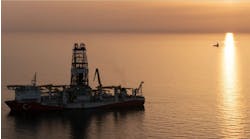Eldon Ball • Houston
The well documented global credit crunch is sending some highly leveraged companies into free fall and posing questions of short and medium-term profitability for others, according to an in-depth analysis byJulian Callanan and Dr. Roger Knight of Infield Systems, London. In this month’s lead story, the two energy analysts look at what was a trying year for all those active in the Gulf of Mexico and discuss the potential impact of recent price, demand, and financial changes.
The nature of a global financial crisis means all countries, and resultantly all industries, are exposed to the unsettling effects of the decay of economic confidence, the authors note.
“In many ways, the slowdown of inter-bank lending came at just the wrong time for the offshore industry. Global activity levels were at record highs, key industry health indicators, such as day rates for drilling rigs and charges for engineering services, also were up, and the general upwards hydrocarbon price movements before Christmas 2007, and certainly before the price spike of 2008, felt like it reflected these operating conditions.”
They discuss the causes – and possible consequences – of the oil price drop in their analysis beginning onpage 38.
Shell’s Perdido sets mooring record
Shell’s Perdido Development project’s drilling and production facility will be the deepest in the world when it begins producing around the turn of the decade, asTracy Dulle, Technology Editor, Surface Systems & Vessels, reports in this month’s Equipment, Construction & Installation lead article.
The direct vertical access (DVA) spar is moored in about 8,000 ft (2,438 m) of water in Alaminos Canyon block 857 in the Gulf of Mexico near the Great White discovery.
With the increased water depth at Perdido come additional challenges due to high water pressure, cold temperatures, and extreme marine conditions, such as wind, waves, currents, and seasonal tropical storms, as well as rugged seafloor terrain. The technical solutions for this amazing installation are detailed in her full report beginning onpage 69.
DOT International, Feb. 3-5 in New Orleans
The Deep Offshore Technology International Conference and Exhibition (DOT) returns to New Orleans this year Feb. 3-5 at the Ernest R. Morial Convention Center.
For 20 years, DOT International has provided a forum to address technical issues, introduce pioneering technology, and discuss lessons learned while exploring, developing, and producing oil and gas in deep and ultra deepwater basins around the world.
DOT is recognized as an event where operators, equipment manufacturers, contractors, and service-providers introduce deepwater solutions. Some of the advanced technologies introduced at DOT now are off-the-shelf, conventional equipment, or mature services.
For details of the program, speakers, panel discussions, and related events, see the report beginning onpage 64.
Critical subsalt challenges
Despite world-class discoveries coming one after another, the massive subsalt plays in the deepwater and ultra deepwater areas of the Gulf of Mexico, Brazil, and elsewhere remain somewhat enigmatic, with a host of technical challenges one British executive likened to “putting somebody on the moon.”
Advances in seismic imaging, vibration-resistant downhole assemblies, steerable drilling systems, and other new generation technologies have helped level the playing field to an extent. Nevertheless, in an arena where well depths can exceed 30,000 ft (9,144 m), well-control problems related to imperceptible pressure regimes, the unpredictable incursion of tar that can slam the brakes on a drilling program, and excessive BHA-wrecking vibration are among the difficulties that make subsalt exploration one of the industry’s most technically demanding ventures.
This monthContributing Editor Jim Redden takes a look at some of the challenges of subsalt exploration and development, drawing on exclusive interviews with experts in the industry. His article beings on page 54.
To respond to articles in Offshore, or to offer articles for publication, contact the editor by email ([email protected]) or fax (1-713-963-6296).


